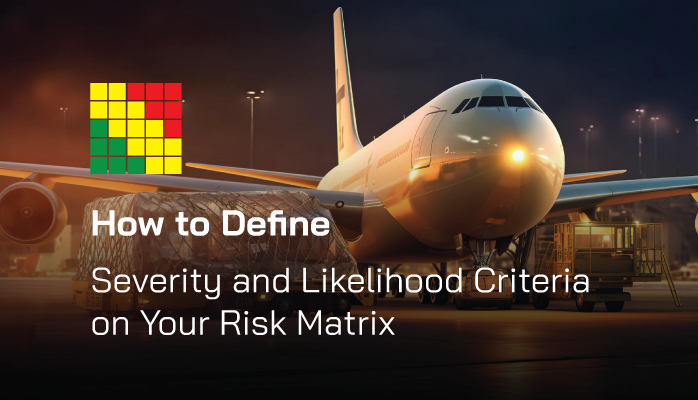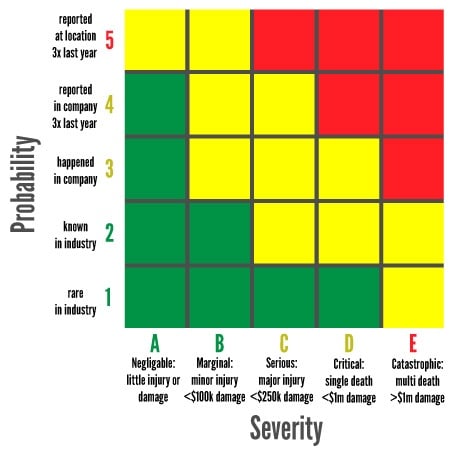What Is a Risk Matrix Used for in Aviation Risk Management

The risk matrix is the standard risk assessment tool in aviation SMS and other risk management industries. It’s a standard tool because it’s simple and accomplishes all of the needs of a risk assessment, namely:
- Rank safety concerns;
- Understand if an issue’s risk is “tolerable”;
- Ensure assessments are consistent; and
- Ensure assessments are easy and intuitive to perform.
In this article, we will look review:
- The purpose of defining criteria for risk matrices;
- What is severity on a risk matrix and how to define criteria for it; and
- What is likelihood on a risk matrix and how to define criteria for it.
Why Define Criteria for Risk Matrix
Defining criteria for each level of likelihood and severity is what makes your risk matrix so valuable. Doing this ensures that:
- You can easily guide for assessing issues;
- You can justify risk assessments to auditors;
- Risk assessments are performed consistently; and
- Acceptable Level of Safety is well defined and has an identifiable visual cue.
Furthermore, defining criteria allows you to “make your risk matrix your own,” so that you are assessing issues with terms that are unique to your organization’s size and needs.
Related Aviation Risk Matrix Articles
- Risk Matrix Samples
- How to Define Your Risk Matrix in Aviation SMS
- What Is a Risk Matrix and Risk Assessment in Aviation SMS
What Is Severity on Risk Matrix
Severity on the risk matrix represents the severity of the most likely consequence of a particular hazard occurrence. In other words, if a hazard occurs and is not mitigated, what is the severity of the most likely problem that will occur? As ICAO says of severity, “the severity... of a hazard’s projected consequence.”
For example, in the event of a hazard “Runway incursion,” the most likely problem that will occur is probably either an Accident or Near Miss. If you determine that an Accident is a most likely probable concern, the severity would be “Catastrophic”. If you determine that Near Miss is the most probable concern, then “Serious” would likely be your severity.
So, when you are defining criteria for severity in your risk matrix, keep in mind that you are defining criteria for the most likely safety incident following a hazard occurrence.
What Is Likelihood on Risk Matrix
Likelihood on a risk matrix represents the likelihood of the most likely consequence occurring in the event of a hazard occurrence. To put it another way, if a hazard occurs, what are the chances the most likely safety mishap will occur?
To use the example from earlier, in the event of a hazard “Runway incursion,” the most likely problem that will occur is probably an Accident. The likelihood of this occurrence would be fairly low, as many control measures are mitigating this problem.
So, when you are defining likelihood in your risk matrix, you should create criteria that define the likelihood of the risk occurrence (not the likelihood of hazard occurrence).
Ways to Define Criteria for Severity on Risk Matrix

It’s extremely important that you use multiple different criteria to define severity on your matrix. These criteria will give you multiple modes of justification for each risk assessment’s severity.
Each level of severity should use the same criteria but have an increase in “damages” for each rising level of severity. Here are some ways to define criteria for severity, with some examples below each type of criteria:
- How much financial damage is associated with each level;
- Level 1: < $1,000
- Level 2: $1,000 - $50,000
- Level 3: $50,000 - $200,000
- Level 4: $200,000 - $1m
- Level 5: < $1m
- How much environmental damage is associated with each level;
- Level 1: Slight/no effect
- Level 2: Minor effect
- Level 3: Localized effect
- Level 4: Major localized effect
- Level 5: Multiple environments affected
- Personnel injury;
- Level 1: Slight/no injury
- Level 2: Minor Injury, no hospitalization
- Level 3: Major injury, hospitalization
- Level 4: Single fatality
- Level 5: Multiple fatalities
- Mission damages.
- Level 1: No effect
- Level 2: Minor degradation
- Level 3: Single significant mission failure element
- Level 4: Total single mission failure
- Level 5: Multiple missions affected
You may have additional qualifying elements you wish to define for Severity that are relevant to your organization. Also, your criteria for each level of severity should certainly be different from the examples above – for example, $1m may be “Catastrophic” for small and medium-sized service providers, but may only be “Moderate” severity for a large operator.
Related Aviation Risk Assessments Articles
- How to Justify Severity of Risk Assessments
- How to Assign Severity and Likelihood to Issues When Assessing Risk
- What Types of Risk Assessments You Should Perform in Aviation Safety
Ways to Define Criteria for Likelihood on Risk Matrix

When defining likelihood, aviation service providers usually define criteria in one of two ways. These two ways are by either:
- Quantitative approach: Number of expected occurrences/operations number of occurrences/time period
- Qualitative approach: Relative chances.
In terms of the quantitative approach, for the number of expected occurrences you might define it as:
- A: (high)
- 1/100 operations
- 5+ occurrence/year
- B: (medium-high)
- 1/500 operations
- 2-4 occurrences/year
- C: (medium)
- 1/1,000 operations
- 1 occurrence/year
- D: (medium-low)
- 1/5,000 operations
- 1 occurrence/3 years
- E: (low)
- 1/20,000 operations
- 1 occurrence/10 years
This can be a good method if you have significant historical data to analyze occurrences per number of operations for specific hazards.

We recommend that most providers use qualitative criteria for defining likelihood, as it’s fairly straightforward and convenient for SMS of all ages and sizes. You might define these criteria as either expected frequency or expected chances of occurrences.
- A: (high)
- Frequent
- Almost certain
- B: (medium-high)
- Common
- Likely
- C: (medium)
- Occasional
- Possible
- D: (medium-low)
- Isolated
- Seldom
- E: (low)
- Almost never
- Unlikely
These are just loose examples, and you should define your chances based on the size, complexity, and number of operations in your company.
NOTE: you can set level A as your high likelihood or low likelihood, as there is no set direction your matrix needs to go.
Last updated August 2024.






